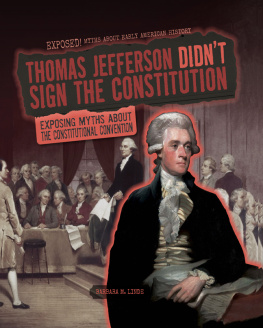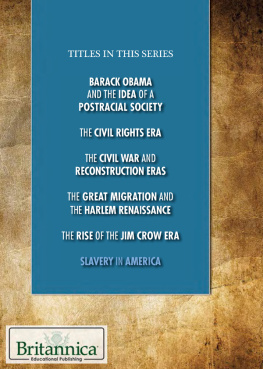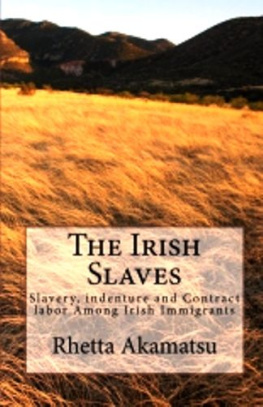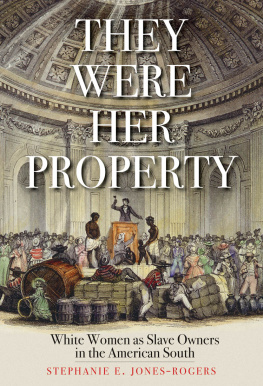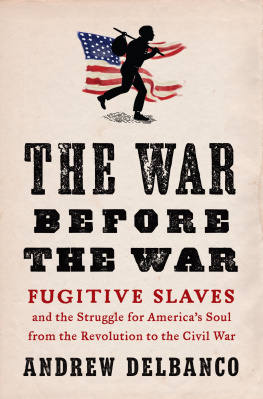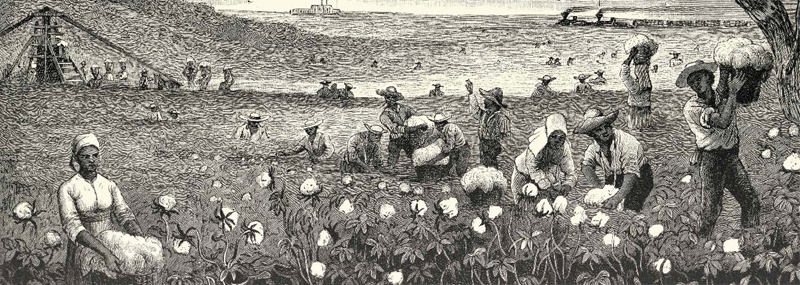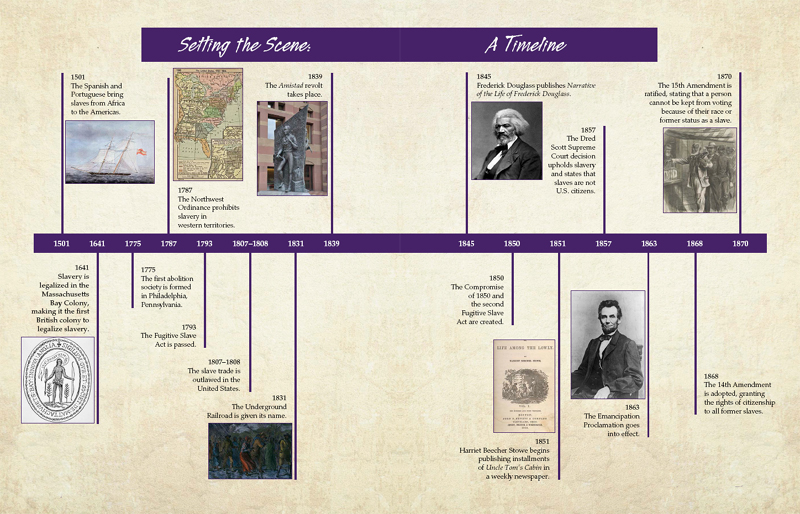Published in 2017 by
Lucent Press, an Imprint of Greenhaven Publishing, LLC
353 3rd Avenue
Suite 255
New York, NY 10010
Copyright 2017 Lucent Press, an Imprint of Greenhaven Publishing, LLC.
All rights reserved. No part of this book may be reproduced in any form without permission in writing from the publisher, except by a reviewer.
Designer: Deanna Paternostro
Editor: Katie Kawa
Cataloging-in-Publication Data
Names: Linde, Barbara M.
Title: Slavery in North America / Barbara M. Linde.
Description: New York : Lucent Press, 2017. | Series: American history | Includes index.
Identifiers: ISBN 9781534560604 (library bound) | ISBN 9781534560598 (ebook) Subjects: LCSH: Slavery--United States--History--Juvenile literature. | Slave insurrections--United States. | Antislavery movements--United States--History--19th century--Juvenile literature. | African Americans--History--To 1863--Juvenile literature. Classification: LCC E441.L56 2017 | DDC 306.3620973--dc23
Printed in the United States of America
CPSIA compliance information: Batch #CW17KL: For further information contact Greenhaven Publishing LLC, New York, New York at 1-844-317-7404.
Please visit our website, www.greenhavenpublishing.com. For a free color catalog of all our high-quality books, call toll free 1-844-317-7404 or fax 1-844-317-7405.
Foreword
T he United States is a relatively young country. It has existed as its own nation for more than 200 years, but compared to nations such as China that have existed since ancient times, it is still in its infancy. However, the United States has grown and accomplished much since its birth in 1776. What started as a loose confederation of former British colonies has grown into a major world power whose influence is felt around the globe.
How did the United States manage to develop into a global superpower in such a short time? The answer lies in a close study of its unique history. The story of America is unlike any otherfilled with colorful characters, a variety of exciting settings, and events too incredible to be anything other than true.
Too often, the experience of history is lost among the basic facts: names, dates, places, laws, treaties, and battles. These fill countless textbooks, but they are rarely compelling on their own. Far more interesting are the stories that surround those basic facts. It is in discovering those stories that students are able to see history as a subject filled with lifeand a subject that says as much about the present as it does about the past.
The titles in this series allow readers to immerse themselves in the action at pivotal historical moments. They also encourage readers to discuss complex issues in American historymany of which still affect Americans today. These include racism, states rights, civil liberties, and many other topics that are in the news today but have their roots in the earliest days of America. As such, readers are encouraged to think critically about history and current events.
Each title is filled with excellent tools for research and analysis. Fully cited quotations from historical figures, letters, speeches, and documents provide students with firsthand accounts of major events. Primary sources bring authority to the text, as well. Sidebars highlight these quotes and primary sources, as well as interesting figures and events. Annotated bibliographies allow students to locate and evaluate sources for further information on the subject.
A deep understanding of Americas past is necessary to understand its present and its future. Sometimes you have to look back to see how to best move forward, and thats certainly true when writing the next chapter in the American story.
Introduction
THE SLAVE TRADE: AN ANCIENT PRACTICE
T he history of slavery goes back almost to the earliest days of civilization. Ancient empires frequently enslaved people, and many slaves were spoils of war. Slavery was often the punishment for committing a crime or not paying a debt. The enslaved people worked at physically demanding tasks with no pay and, most of the time, no path to eventual freedom. In many societies, any children born to an enslaved female also became slaves for life, perpetuating the institution.
In ancient China, slaves, along with soldiers and criminals, were used to begin building the Great Wall. Owning slaves was a sign of prominent social status in ancient Greece. Soldiers took their slaves with them; they often fought alongside their masters or rowed the boats for the Greek navy. The Greek philosopher Aristotle believed that slaves were unequal, and even inferior to, Greek citizens. His ideas were widely accepted in Greek society:
The lower sort are slaves by nature: it is better for them, as for all inferiors, that they should live under the direction of a master And indeed the use made of slaves and of tame animals is not very different It is clear then that some men are by nature slaves and that to keep them as slaves is not just advantageous but right.1
Slavery was also common in the Roman Empire. Slaves were treated as property and had no rights. They worked in the fields, worked in the mines, and did housework.
On the other side of the world, slavery was also practiced by the ancient people of Central America and South America. The Maya, the Aztecs, and the Incas all used slaves. In many cases, however, these civilizations did not force people to remain slaves forever. Slaves could buy their freedom, and children born to slaves were not always forced into a life of slavery.

This mosaic shows a slave in the Roman Empire.
Slavery and Religion
The practice of slavery continued into the Middle Ages in Europe. Viking raiders in northwestern Europe regularly took slaves from groups they conquered. In the 1400s and 1500s, religion played a large part in the practice of slavery. European Christians believed that it was acceptable to enslave non-Christians. During this time period, the popethe highest leader of the Catholic Churchsometimes spoke out in favor of slavery and even gave slaves as gifts or kept his own slaves.
As time went on, however, religious leaders, including some popes, began speaking out against slavery. Religion ultimately played an even larger role in the antislavery movements of the 1700s and 1800s.
The New World and the Age of Discovery
The practice of slavery continued during the Age of Discovery, when Christopher Columbus and others began exploring the New World of North America, Central America, and South America. As history now shows, this was a time of exciting discoveries, but it was also a time of great tragedy for certain groups of people, including the Africans who were brought to the New World as slaves.
Chapter One
THE BEGINNING OF THE SLAVE TRADE IN NORTH AMERICA
S lavery in the Western Hemisphere grew as colonization grew in the New World. Spain began by colonizing islands in the Caribbean. Gradually, the country also set up colonies in modern-day Florida, Mexico, and the southwestern United States. France, meanwhile, explored and colonized parts of Canada and some of the more northern portions of what is now the United States. It also had colonies in the area around contemporary Louisiana. England, meanwhile, set its sights on the Atlantic Coast.






